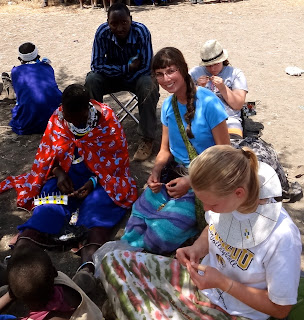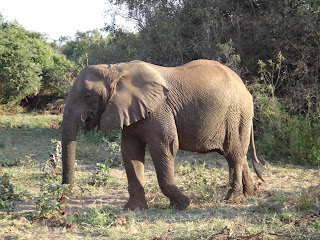One day, we had a field trip to a Maasai community in Mto Wa Mbu. The Maasai is a local tribe with certain cultural values that primarily involves a nomadic lifestyle. Their wealth is measured in cattle, and much of their daily life depends on cow products (milk, meat, and blood). Also, a woman is given away with a dowry of cattle. Circumcision is a common practice among men (and sometimes women) in this culture. Men are circumcised when they are 15 as part of an initiation ceremony to becoming a Maasai warrior. He has long long dark string woven in his hair for a couple of years after his circumcision. All other males and females wear their hair cropped very short.
We had a special homestay with the Maasai people that most tourists do not even get to witness. When we arrived in the vehicles, we were received with a traditional welcome song that involved lots of grunting, throaty croaking, yips, and women singing a tune rather than words. As part of the ceremony, the men engage in a jumping competition, where the highest jumper wins (top). Women and children sing and lift their shoulders up and down to bump their large beaded necklaces in time to their song (middle). A baby girl wasn't satisfied with the song and bumping of her matrons, and instead waddled over to the jumping men. She made cute little jumping motions, but had both feet planted for fear of toppling over (bottom). Many of the students were dragged into the jumping, song and necklace bumping, however I stayed and documented the event.
After the warm welcome, we were split up into small groups, and taken to see the inside of a Maasai house. They are built kind of like a cinnamon role, where the door is parallel with the walls of the house, and leads into a dark open space with a bench, and 2 hard cow-hide beds for the parents and children. What is interesting is that the kids sleep together until the boys turn 7, in which case they need to find another place to sleep. Their kitchen is a tiny fire pit in the middle of the small 3x3ft open space. They demonstrated how they make a fire with a machete, soft acacia, hard acacia, highly flammable donkey dung, and dry grass.
Afterwards, we separated into different groups that were going to learn how to do wood carving, herding, making beaded jewelry, tire shoes, traditional cooking, spear throwing, and house building. I signed up for wood carving, thinking that I could make a really sweet Maasai club. Instead, we ended up smoothing out the scratches on already made clubs and herding sticks with a pocket knife. It was still really cool to help them out with that, considering all of us were girls, and women do not participate in wood carving as a general rule. Our class was bending the rules in many ways: girls were herding cattle, whereas guys were making bead jewelry, cooking and making houses (women are homemakers, even in the literal sense). Skeletons of the houses are made from acacia limbs, and the walls are constructed out of cow dung and ash. Since Maasai are nomadic people, they do not build permanent residences anywhere. When I got tired of wood carving, I tried my hand at bracelet making. I had a great idea to make a bracelet with the colors of the poisonous coral snake, with white fangs for the center piece, but I ran out of time only half way through before lunch.

Lunch was prepared by our camp cooks in order to ensure that the preparation was sanitary. It was sanitary until we had to eat with our hands because the staff forgot forks (I felt bad for the people that were building houses and had cow dung on their hands...they washed but you can't help but think about the fact that you were handling cow poo moments before. After the students were served, the main men of the tribe (chief and son) took portions next, then the women and children. They must have been starving, because they filled their plates until food was falling off. The Maasai warriors didn't get to eat because women had seen the fat that they cooked with. I still don't understand this, but as part of their culture, Maasai warriors are not supposed to eat food if certain aspects of it are viewed by women.
As part of an assignment, we had to interview some of the villagers to
get an idea of the major problems they encounter, that primarily involves
water and food shortage during drought, wild predators, health and
education issues.
We left shortly thereafter because it was very hot, and all of the activities were dwindling. The tribe sent us off with a goodbye song and dance, which was much like the welcome song and dance come to think of it. Still, very cool!


















































